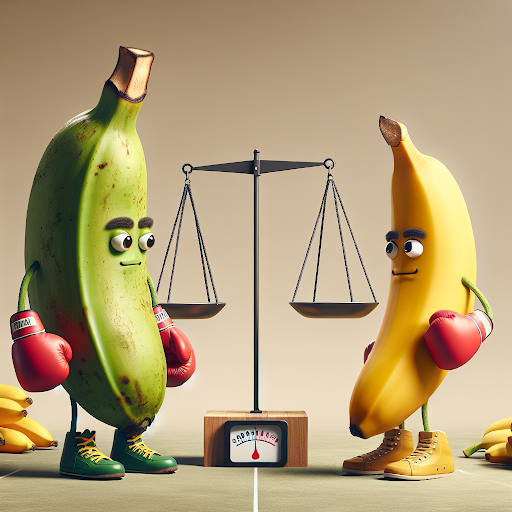As a nutritionist and avid banana enthusiast, the idea of exploring alternatives opens up a world of possibilities. Plantains, with their unique taste and texture, emerge as an intriguing candidate for substituting bananas in various culinary endeavors. In this comprehensive guide, we’ll delve into the nutritional benefits of both fruits, compare their pH levels, and unravel the culinary versatility of plantains as a substitute for bananas.
Nutritional Face-Off: Plantains vs. Bananas
1. Plantains: The Starchy Powerhouse
Plantains, often mistaken for bananas, offer a distinct nutritional profile. Rich in complex carbohydrates and starch, plantains provide a substantial source of energy. They are a good source of vitamins A and C, as well as minerals like potassium and magnesium.
Nutritional Content of Plantains (Per 100g)
| Nutrient | Amount |
| Calories | 122 |
| Carbohydrates | 31.9g |
| Dietary Fiber | 2.3g |
| Vitamin A | 1127IU |
| Vitamin C | 18.4mg |
| Potassium | 499 mg |
| Magnesium | 37 mg |
2. Bananas: The Nutrient-Rich Energizer
Bananas, a well-loved fruit worldwide, are renowned for their natural sweetness and nutritional content. They are an excellent source of dietary fiber, vitamin C, potassium, and vitamin B6.
Nutritional Content of Bananas (Per 100g)
| Nutrient | Amount |
| Calories | 89 |
| Dietary Fiber | 2.6g |
| Potassium | 358mg |
| Vitamin C | 8.7mg |
| Vitamin B6 | 0.4mg |
pH Levels: A Peek into Acidity
Understanding the pH levels of banana and fruits is crucial when considering substitutes. The pH level indicates the acidity or alkalinity of a substance. Let’s compare the pH levels of plantains and bananas.
pH Levels of Plantains and Bananas
| Fruit | pH Level |
| Plantains | 5.2 – 5.7 |
| Bananas | 4.5 – 5.2 |
Plantains in Culinary Exploration
1. Cooking Versatility Unveiled:
Plantains, often called the “cooking banana,” showcase a culinary spectrum that extends far beyond the traditional sweet banana. Their starchy and less sweet taste opens up a world of possibilities in the kitchen. Here’s a closer look at their culinary versatility:
Savory Delights:
Fried Plantains: Sliced plantains fried to golden perfection are a staple in many cuisines. The contrast of crispy exterior and tender interior makes them a delightful side dish or snack.
Plantain Chips: Thinly sliced and baked or fried, plantain chips offer a crunchy alternative to potato chips, perfect for dipping or snacking.
Mains and Sides:
Mofongo: A Puerto Rican dish where plantains are mashed and mixed with garlic, pork cracklings, and other ingredients, creating a flavorful and hearty dish.
Plantain Tamales: Plantains can be incorporated into tamale dough, adding a unique twist to this traditional Latin American dish.
Desserts with a Twist:
Plantain Bread: A creative take on banana bread, using plantains for a denser texture and a mildly sweet flavor.
Plantain Pudding: Mashed plantains can be incorporated into pudding recipes, offering a tropical twist to this classic dessert.
2. Nutritional Bounty Unleashed:
Plantains not only bring a diversity of flavors but also a nutritional boost to the table. While sharing some nutritional elements with bananas, plantains stand out with their higher levels of vitamins A and C.
Vitamins A and C:
Vitamin A: Essential for vision, skin health, and immune function, plantains offer a substantial dose of vitamin A, contributing to overall well-being.
Vitamin C: Known for its antioxidant properties, vitamin C in plantains supports immune health and collagen formation.
Potassium Enrichment:
Potassium: Both plantains and bananas contribute to daily potassium intake. This mineral is crucial for heart health, muscle function, and maintaining proper fluid balance.
Dietary Fiber Goodness:
Dietary Fiber: Plantains, like bananas, provide dietary fiber, promoting digestive health and contributing to a feeling of fullness.
FAQs: Navigating Plantains as a Banana Substitute
Q1: Can plantains be used interchangeably with bananas in smoothies?
A1: Yes, plantains can be used in smoothies, but the flavor and texture will differ. Adjusting other ingredients can help achieve the desired taste.
Q2: Are plantains a healthier alternative to bananas?
A2: Plantains and bananas offer different nutritional benefits. Plantains are starchy and provide more vitamins A and C, while bananas are known for their natural sweetness.
Q3: How does the pH level of plantains compare to that of bananas?
A3: Plantains have a slightly higher pH level than bananas, making them less acidic. Understanding pH levels is essential when considering their use in different recipes.
Q4: Can plantains be used in dessert recipes that traditionally call for bananas?
A4: Absolutely! Plantains bring a unique flavor to desserts. Experimenting with recipes can lead to delightful culinary discoveries.
Conclusion: Embracing Diversity in the Fruit Bowl
In the plantains vs. bananas debate, the answer lies in the culinary context and personal preference. Plantains, with their starchy richness and higher pH levels, offer a distinctive alternative to the sweet and familiar taste of bananas. Whether you’re exploring savory dishes, seeking a nutrient boost, or experimenting with baking, plantains bring a unique flavor profile to the table. Embrace the diversity in the fruit bowl, savoring the goodness of both plantains and bananas in their own delicious ways.
